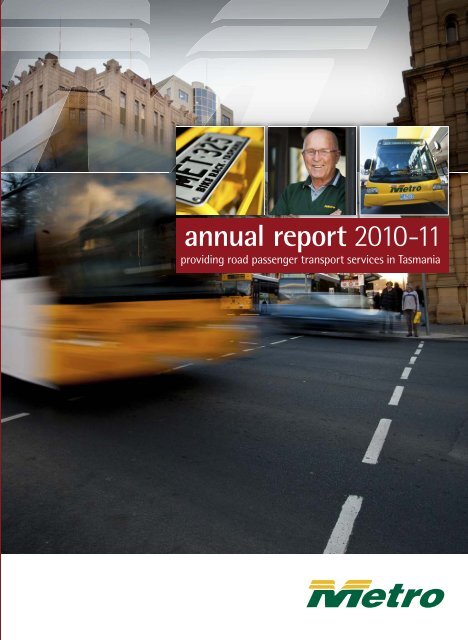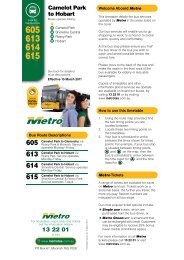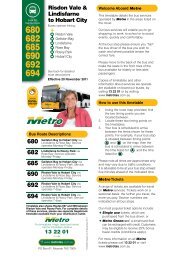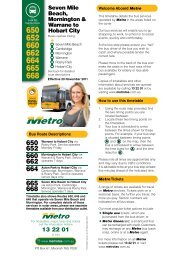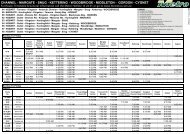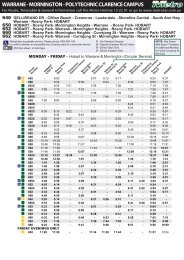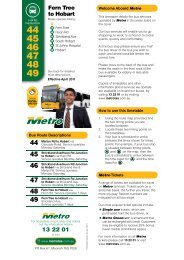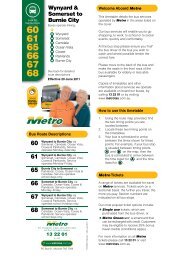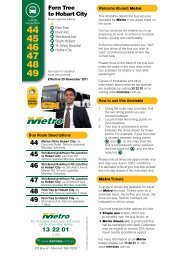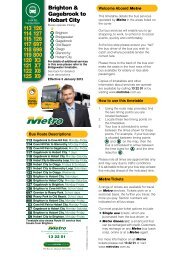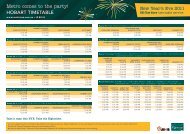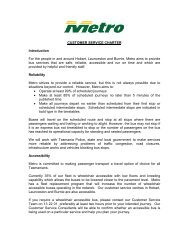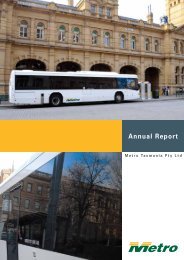annual report 2010-11 - Metro Tasmania
annual report 2010-11 - Metro Tasmania
annual report 2010-11 - Metro Tasmania
Create successful ePaper yourself
Turn your PDF publications into a flip-book with our unique Google optimized e-Paper software.
<strong>annual</strong> <strong>report</strong> <strong>2010</strong>-<strong>11</strong>providing road passenger transport services in <strong>Tasmania</strong>
CONTENTSCompany Overview 1Chairperson’s Review 2Chief Executive Officer’s Review 4Our Performance 6Our Workforce 9Our Customers 12Our Community 14Board of Directors 16Directors’ Report 18Auditor’s Independence Declaration 20Directors’ Declaration 21Independent Audit Report 22Financial Statements 25Nature of BusinessProvision of road passenger transport services.Issued CapitalTwo shares of $1.00 each.Registered Office212 – 220 Main RoadMoonah, TAS 7009ABN Number30 081 467 281DirectorsRon Ward, ChairpersonLynn Mason, Deputy ChairpersonGeoffrey HazellTracy MatthewsIan NewmanMike WisbyShareholdersMinister for Sustainable TransportTreasurerExecutive ManagersHeather Haselgrove, Chief Executive OfficerAnita Robertson, Chief Financial Officer andCompany SecretaryAlan Pedley, General Manager OperationsIan Ward, General Manager Infrastructureand EngineeringAnthony James, General Manager BusinessDevelopment and PlanningCraig Anderson, Manager Human ResourcesRodney Byfield, Chief Information OfficerBankersCommonwealth Bank of Australia81 Elizabeth StreetHobart, TAS 7000AuditorAuditor-General<strong>Tasmania</strong>n Audit OfficeLevel 4/15 Murray StreetHobart, TAS 7000METRO Annual Report <strong>2010</strong> | 20<strong>11</strong>
COMPANYOVERVIEW<strong>Metro</strong> <strong>Tasmania</strong> Pty Ltd (<strong>Metro</strong>) is a state-ownedcompany established in February 1998.It is <strong>Tasmania</strong>’s largest passengertransport service provider, operatinga fleet of 224 buses in and aroundHobart, Launceston and Burnie.<strong>Metro</strong> services are delivered underservice contracts with the StateGovernment’s Transport Commissionthat sits within the Departmentof Infrastructure, Energy andResources.Operating under CorporationsLaw, an independent Board of sixDirectors provides the organisationwith strategic direction andgovernance.<strong>Metro</strong>’s shareholder ministers,representing the people of <strong>Tasmania</strong>,are Minister for SustainableTransport Hon Nick McKim andTreasurer Hon Lara Giddings.<strong>Metro</strong>’s corporate plan, developedin consultation with the company’semployees, has set the vision,business, purpose, goals and valuesto take the company forward.Our VisionTo transform <strong>Tasmania</strong>’s passengertransport to be a travel option ofchoice.Our Business PurposeTo deliver urban mass transitpassenger transport services.Our GoalsGoal #1 Lead the repositioningof passenger transportwithin <strong>Tasmania</strong> withkey stakeholders.Goal #2 Put the customer at thecentre of our business.Goal #3 Develop a skilled, engagedand healthy workforce.Goal #4 Grow the market bypartnering with industry.Goal #5 Build a sustainable andprogressive business.Our ValuesSafety consciousSafety is everybody’s responsibility.It is at the forefront of all of <strong>Metro</strong>’sactions.RespectfulRespect for the customer, staff andstakeholders, investing in individualand community growth anddevelopment.CollaborativeWorking in an approachable,communicative, responsive,transparent and consultative mannerin everything we do.CourageousThe courage to act to achieve<strong>Metro</strong>’s vision and business purpose,even in the face of challenge oradversity.METRO Annual Report <strong>2010</strong> | 20<strong>11</strong> 1
CHAIRPERSON’SREVIEW<strong>Metro</strong> <strong>Tasmania</strong>’s vision is to transform passengertransport to be a travel option of choice.I am pleased to <strong>report</strong> that during<strong>2010</strong>-<strong>11</strong> <strong>Metro</strong> continued to buildon the work of previous yearstowards achieving this vision againstits key benchmarks.In our three-year corporate planthe Board set goals which deal withthe way the corporation relatesto its shareholders, stakeholders,customers and our own workforce,and what it wants to achieve.Our goals are to put our customersat the centre of our business, toincrease the number of peopleusing passenger transport and todeliver value for money to bothour bus passengers and the StateGovernment which, through theDepartment of Infrastructure,Energy and Resources (DIER),contracts <strong>Metro</strong> to provide a levelof service.<strong>Metro</strong> is a state-owned company,but unlike other governmentbusiness enterprises, it is not set upto make a profit nor pay a dividendto its Government shareholders.During the <strong>report</strong>ing year DIER,through the Transport Commission,2 METRO Annual Report <strong>2010</strong> | 20<strong>11</strong>provided $33.90 million underservice contracts to provide busservices in Hobart, Launceston andBurnie. Our other major source ofincome is from passengers throughticketing fares which in the <strong>2010</strong>-<strong>11</strong>year amounted to $10.88 million -or about 25% of our income.<strong>Metro</strong>’s major expenses includeemployee wages and salaries, fueland maintenance of buses.For the <strong>2010</strong>-<strong>11</strong> year <strong>Metro</strong> had anoperating loss of $73,000. Duringthe financial year, the companyspent $5.97 million on new capitalequipment - primarily the purchaseof eight new buses, including four12.5 metre buses and four new lowfloor articulated buses - the firstarticulated buses to be put intoservice in <strong>Tasmania</strong> in over20 years. The latter was funded byan additional $3.25 million providedby DIER in <strong>2010</strong> to improve <strong>Metro</strong>’spassenger bus fleet and to assistwith <strong>Metro</strong>’s long-term capitalreplacement program.The management of <strong>Metro</strong> withthe board’s encouragement isdriving efficiencies within thebusiness. For example, we arecurrently investigating the depotconfiguration in Hobart. Atpresent we have the large depotat Springfield and a numberof satellite yards where busesare parked overnight. We arequestioning whether this is the rightconfiguration or whether we shouldhave smaller depots at the ends ofmajor routes to cut down the deadrunning between routes.Under our corporate plan one ofour key goals is to improve socialinclusion. Currently <strong>Metro</strong> has78 low floor buses in its fleet of 224buses. As we progressively replaceand upgrade the fleet, all new buseswill be capable of being lowered andhave ramps to improve access forpeople with disabilities.Another of <strong>Metro</strong>’s primary aimsis to increase passenger numbersand we have a number of strategiesin place to progressively achievethat aspiration. In the <strong>2010</strong>-<strong>11</strong>year passenger boardings totalled10.55 million, an increase of almost500,000 on the previous year.
While <strong>Metro</strong> is a state-ownedcompany, we are very aware of thecommunity in which we operateand understand that some of ourcustomers are presently finding itdifficult to make ends meet.To this end the <strong>Metro</strong> Board decidedto only increase adult fares bythe Consumer Price Index and todelay their introduction to January20<strong>11</strong>. Additionally, the majority of<strong>Tasmania</strong>n students and concessioncard holders were shielded from busfare increases.The <strong>Metro</strong> Board is constantlylooking for ways to improvestakeholder relations and how itinteracts with its stakeholders.In that context an initiative in thepast year has been to implementa program of meetings with localcouncils to inform them of <strong>Metro</strong>’splans and to invite feedback onissues affecting them.We are currently reviewing ourCustomer Service Charter toimprove in areas such as reliability,accessibility, capacity, the provisionof timetable and ticketinginformation and the way werespond to customer feedback.Recently a <strong>report</strong> was commissionedto establish the corporation’s carbonfootprint and to identify ways <strong>Metro</strong>can become more environmentallysensitive and reduce its footprint.There were no changes to the <strong>Metro</strong>Board and one new appointmentto the executive management teamduring the <strong>report</strong>ing year.I would like to thank my fellowDirectors, the CEO and hermanagement team and all ouremployees for their hard work thathas set the corporation on a journeyof improvement and on realisingour corporate goals, particularlyin terms of customer service andincreased passenger numbers.Ron WardChairpersonAs we progressivelyreplace and upgradethe fleet, all newbuses will be capableof being loweredand have rampsto improve accessfor people withdisabilities.METRO Annual Report <strong>2010</strong> | 20<strong>11</strong> 3
CHIEF EXECUTIVE OFFICER’SREVIEWThe past financial year has been a busy and successfulone for <strong>Metro</strong> <strong>Tasmania</strong>.During <strong>2010</strong>-<strong>11</strong> we have witnessedcontinued growth in passengernumbers, the purchase andcommissioning of eight new buses,high levels of customer satisfaction,the implementation of newservice initiatives and improvedcommunication with all ourstakeholders.PatronageIn his <strong>report</strong> our ChairpersonRon Ward has already mentionedthe increase in passenger numbersacross the state, with the strongestgrowth in Launceston. Overallpassenger numbers increasedfrom 10.03 million in 2009-10to 10.55 million in <strong>2010</strong>-<strong>11</strong>.After adjustments for the numberof weekdays, passenger boardings inHobart increased from 7.79 millionto 8.13 million, Launceston from1.79 million to 1.94 million andBurnie from 464,433 to 467,846during the period.This is the third year running thatpassenger numbers have increasedand this is attributed partly to4 METRO Annual Report <strong>2010</strong> | 20<strong>11</strong>the introduction of the <strong>Metro</strong>Greencard. Since its introductionin 2009, more than 74,000 peoplehave been issued with Greencards.Over 54% of all boardings are nowmade with a Greencard.A number of other initiatives duringthe year were aimed at promotinggreater use of <strong>Metro</strong> bus services.One of these was a highly successful‘fare free’ weekend on the longweekend commencing February12 to coincide with major eventsincluding Festivale in Launceston,the Hobart Regatta, Hobart Cup,the Wooden Boat Festival and aSheffield Shield cricket match atBellerive Oval.The offer gave people anopportunity to experience bustravel, with the aim of encouragingmore people to uses buses astheir travel mode of choice.Over the course of this weekend<strong>Metro</strong> carried 45,683 passengers.The number of passengers carriedon the equivalent long weekendin <strong>2010</strong> doubled. <strong>Metro</strong> is alsopartnering local government andmajor event organisers like the<strong>Tasmania</strong>n Cricket Associationwith the ‘Boundary Rider’ serviceto international cricket, and theopening of MONA, to encouragepeople to park away from venuesand ride buses to and from eventsto avoid traffic congestion.To increase patronage and improvethe convenience of bus travel,<strong>Metro</strong> is overhauling all of itstimetables statewide to ensure theyare more accurate and more easilyunderstood. We’re also improvingthe information available at busstops and on our website, includingthe use of Twitter alerts to allowpeople to get real time informationabout issues affecting services.<strong>Metro</strong> will soon introduce a journeyplanner on the website to make iteasier for people to plan their trip.FacilitiesIn addition to upgrading our busfleet with modern, more ecofriendlyand accessible buses,<strong>Metro</strong> is undertaking a program toprogressively upgrade bus sheltersand seating - especially at stops
The ‘fare free’weekend on thelong weekendcommencing12 February tocoincide withmajor eventsincluding Festivalein Launceston, theHobart Regatta,Hobart Cup, theWooden BoatFestival and aSheffield Shieldcricket match atBellerive Oval.where research indicates a greaterneed. During <strong>2010</strong>-<strong>11</strong> <strong>Metro</strong> begana trial at several stops throughoutGreater Hobart to install seats madefrom recycled plastic.Another initiative aimed at reducingtraffic congestion, meeting acommunity transport need andimproving our service, is a trial ofbike racks on some buses on someroutes. Drivers are currently beingtrained and the trial will start laterin 20<strong>11</strong>.<strong>Metro</strong> has secured new premisesin the Elizabeth Street bus mall torelocate and centralise customerservices and ticketing. Whencompleted, the new premises willprovide a more convenient andaccessible shop for our Hobartcustomers.<strong>Metro</strong> continues to work withKingborough Council and the StateGovernment on the development ofa ‘Park and Ride’ facility at Kingston.From 1 July 20<strong>11</strong>, all <strong>Metro</strong> facilitieshave been smoke free.Customer Charter<strong>Metro</strong>’s Customer Service Charterstates that we aim to provide busservices that are safe, reliable,accessible and run on time andwhich are provided by helpful andfriendly staff.During the year we began a reviewof the charter to bring it up todate. What it says is that we aim tooperate at least 99% of scheduledjourneys and make at least 85%of scheduled journeys arrive nolater than five minutes after thepublished time.Accessibility<strong>Metro</strong> is committed to making bustransport a travel option of choicefor all <strong>Tasmania</strong>ns. Currently 35%of our fleet is wheelchair accessiblewith low floors and kneelingcapability, which allow the buses tobe lowered closer to the pavementlevel. <strong>Metro</strong> has a fleet replacementprogram that will increase thenumber of wheelchair accessiblebuses operating in the network.The eight new buses purchased andcommissioned during the year areall wheelchair accessible.SafetySafety is everyone’s responsibilityand is at the forefront of <strong>Metro</strong>’sactions. By that we mean safetyfor our bus customers, for our busoperators and other staff and forthe general public.During <strong>2010</strong>-<strong>11</strong> there have been afew unfortunate, high profile eventswhich have rightly raised questionsabout passenger safety. In eachcase <strong>Metro</strong> has moved quickly toinvestigate and, where appropriate,put in place new procedures orprotocols to address these issues.All <strong>Metro</strong> buses are fitted with CCTVcameras to monitor both inside andoutside buses. Additionally, <strong>Metro</strong>works closely with <strong>Tasmania</strong> Policewhich has officers stationed at theHobart Depot to handle issues andprovide advice.<strong>Metro</strong>’s <strong>2010</strong> Customer SatisfactionSurvey found that 91% of passengersagreed with the statement: ‘I alwaysfeel safe when on a bus in Hobart/Launceston’ which is very similar tothe 2009 survey (90%). The surveyalso found that a large majority(87%) of passengers felt safe whenwaiting for a bus and when gettingoff a bus.Over the past year <strong>Metro</strong> hasalso been successful in reducingworkers’ compensation costs, whichis an indicator of our work withemployees to reduce injuries in theworkplace.EmploymentAgreementsDuring <strong>2010</strong>-<strong>11</strong> <strong>Metro</strong> negotiatednew Employment Agreements withall its employees. The EmploymentAgreement with <strong>Metro</strong>’s 370bus operators will see improvedefficiency in return for a 3% payrise for each of the next two yearseffective from 1 January 20<strong>11</strong>.Other staff agreements haveresulted in 3% pay increasesfor each of the next three yearseffective from 1 July <strong>2010</strong>(Admin/Clerical) and from 1 October20<strong>11</strong> (Engineering and Workshop).The agreements are financiallyresponsible and sustainable and fairto our employees. The agreementwith the bus operators also includesmeasures to reduce fuel costs andimprove productivity across thebusiness.A lot has been achieved this yearand our goal is to continue with newprograms and initiatives to furtherimprove the service. This would notbe possible without the support andhard work of all our employees.Heather HaselgroveChief Executive OfficerMETRO Annual Report <strong>2010</strong> | 20<strong>11</strong> 5
OURPERFORMANCEPassenger LevelsThis year, 10.55 million boardingswere recorded on <strong>Metro</strong> busservices – an increase of 5.1%.Travel in Hobart increased by4.4%, Launceston increased by aconsiderable 9.5%, whilst Burniehad an increase of 0.7%.Student and concession firstboardings increased by 4.9% and2.5% respectively, whilst adultfirst boardings declined by 3.5%.A 15.2% increase in transfersreflects the change in the waythe Greencard ticketing systemrecords second and subsequentboardings for Day Rover and DayTripper tickets (they are countedas transfers rather than firstboardings).The use of Greencard increased by9.2%, with over 54% of journeysthis year being made using aGreencard. 20,800 Greencardswere issued in <strong>2010</strong>-<strong>11</strong> and at30 June 20<strong>11</strong> <strong>Metro</strong> had issued74,100 Greencards since its launch.Figure 1 – Total Boardings17.8% 17.8%4.6% 4.6%77.6% 77.6%Hobart Hobart Launceston Launceston Burnie BurnieFigure 2 – Boardings by Passenger Type40%35%30%25%20%15%10%5%0%<strong>2010</strong> 20<strong>11</strong>Student First BoardingsAdult First Boardings18.5% 18.5%4.4% 4.4%2009/10 <strong>2010</strong>/<strong>11</strong>77.1% 77.1%Hobart Hobart Launceston Launceston Burnie BurnieConcession First BoardingsTransfer Boardings6 METRO Annual Report <strong>2010</strong> | 20<strong>11</strong>
Service InitiativesThe following service initiatives wereimplemented in <strong>2010</strong>-<strong>11</strong>:Statewide<strong>Metro</strong> NightRider services wereprovided to selected suburbs inHobart on certain days during theChristmas and New Year period.NightRider services were providedin Launceston and Burnie on NewYear’s Eve. Sponsorship for theseservices was provided by MAIB.<strong>Metro</strong>’s ‘Have a Weekend on us’ farefree weekend aimed to encouragemore people to use passengertransport. Free travel was offeredon regular services and routes from12 to 14 February 20<strong>11</strong>. The weekendcoincided with many major eventsincluding the Australian WoodenBoat Festival, the Hobart Regatta,Festivale and the Hobart Cup. Thenumber of passengers using servicesthroughout the fare free weekendmore than doubled compared withthe same weekend the previous year.HobartTen additional bus services per daywere introduced to run betweenKingston and Hobart. These servicesformed the basis of a park and ridefacility in Denison Street, Kingston.70% Figure 3 – Usage of Greencard since statewide implementation60%50%40%30%20%10%0%Sep-09Dec-09Mar-10Jun-10Sep-10<strong>Metro</strong> and Cricket <strong>Tasmania</strong>, inpartnership with the four Hobartmetropolitan councils, put in placethe special <strong>Metro</strong> Boundary Riderservice to give cricket patrons theopportunity to park their vehicles atfour designated car parks and catcha bus to and from Bellerive Oval. TheBoundary Rider services operated forthe one-day international betweenAustralia and England and forthree domestic Twenty20 matchesthroughout January.In partnership with MONA, <strong>Metro</strong>provided services for the MONAopening weekend events in January20<strong>11</strong>. Services were provided fromFranklin Square to Moorilla andfrom a park and ride facility at theDerwent Entertainment Centre.Dec-10Mar-<strong>11</strong>Jun-<strong>11</strong>TotalAdultConcessionStudentLaunceston<strong>Metro</strong> continues to operate theTiger Bus service which is a 15minute weekday peak period shuttlefrom Inveresk to Launceston CBDand an interpeak 30 minute cityloop. This service is funded by theLaunceston City Council.OvercrowdingA number of service changes wereimplemented in March and April20<strong>11</strong> to address overcrowding ongeneral access and school busservices. This involved identifyingand reallocating under utilisedresources to provide services onovercrowded routes.METRO Annual Report <strong>2010</strong> | 20<strong>11</strong> 7
OURPERFORMANCE<strong>Metro</strong> Fleet<strong>Metro</strong> operates a fleet of 224 busesall of which are fitted with CCTV.A third of the fleet is wheelchairaccessible and 21% of buses areair conditioned.WebsiteThe <strong>Metro</strong> website www.metrotas.com.au provides a wide range ofinformation to passengers including:• Timetables and maps• Tickets and fares• Greencard ticketing system• News and service changes• Company overview• How to contact <strong>Metro</strong> and providecustomer feedbackApproximately 600,000 visitswere made to the <strong>Metro</strong> website in<strong>2010</strong>-<strong>11</strong>.Most visits were to view timetablesand services and to manageGreencards.<strong>Metro</strong> is finalising a journey plannerfor passengers, to enable intendingpassengers to plan their journeyfrom their home, workplace or aweb enabled mobile phone.8 METRO Annual Report <strong>2010</strong> | 20<strong>11</strong>Figure 4 – Buses in Service (as at 30 June 20<strong>11</strong>)1870Figure 5 – Buses with Special Features100%80%60%40%20%0%4 6 4Public InterestDisclosures122Hobart Launceston Burnie Statewide<strong>Metro</strong> is required to establishprocedures for the disclosure andinvestigation of improper conduct ordetrimental action. These proceduresare accessible via <strong>Metro</strong>’s website.No disclosures were made to orabout <strong>Metro</strong> during the financial year.ScaniaScania Low Floor (12.5m)Volvo ArticulatedScania Low Floor ArticulatedM.A.N.Scania Low Floor (14.5m)% Video Surveillance % Accessible Services 1% Accessible Buses % Air Conditioned¹ This is the percentage of services operated with an accessible bus, not the percentage advertised asaccessible. The percentage may fall on a given day if an accessible bus is not available.Right to InformationTo ensure compliance with the newRight to Information legislation,<strong>Metro</strong> has modified existing Freedomof Information procedures andupgraded its website to includethe assessed disclosure form.During the year <strong>Metro</strong> received twoassessed disclosure requests whichwere supplied with the requiredinformation.
OURWORKFORCEEmployee turnover has been stable in the past twelvemonths compared with the previous year.WorkforceNumber of employees at30 June 20<strong>11</strong>:Hobart 345Launceston 93Burnie 23Number of full-time equivalentemployees at 30 June 20<strong>11</strong>:Hobart 313Launceston 80Burnie 18Recruitment<strong>Metro</strong> has been able to fill allvacancies for management andprofessional positions includingsome positions in BusinessDevelopment and Planning thathave very small applicant pools.The high response rate to <strong>Metro</strong>advertisements placed onlineor in newspapers has providedhigh quality candidates for mostpositions. Bus operator recruitmenthas continued throughout the yearwith fifty-two bus operators hiredand inducted into the <strong>Metro</strong> ranks.Climate SurveysA climate survey provided bythe ‘Voice Project’ (MacquarieUniversity, NSW) was undertakenlate in <strong>2010</strong>. The results of thesurvey were communicated tothe workforce and a managementworkshop held to plan responsesto the identified issues raised inthe survey. A number of actionsincluding the introduction ofa weekly newsletter have beencompleted as a result of theemployee feedback contained inthe survey. Further surveys willbe conducted in the future tomeasure employees, views onmanagement actions.Employee RelationsDuring the year EnterpriseBargaining Agreements wererenegotiated with the AustralianManufacturing Workers Unionand the Rail, Tram and Bus Union.The negotiated wage increaseswere within budgetary limits andwill provide for stable workingconditions over the next two tothree years. <strong>Metro</strong> also enteredinto three-year agreements with itsadministration and clerical staff.EmployeeDevelopmentA modified performancemanagement system has beenintroduced for all admin/clericalemployees to provide feedback onwork performance and identifydevelopmental opportunities.During the year staff completedvarious courses including:• Time management;• Supervisory development;• First aid;• Harassment and Discrimination;• Report writing;• Tender evaluation; and• Specialist software applications.METRO Annual Report <strong>2010</strong> | 20<strong>11</strong> 9
OURWORKFORCEBus operators employed by <strong>Metro</strong>are enrolled in the Certificate IIIin Transport and Distribution. Thisyear twenty-three employees havesuccessfully gained this qualification.Other external training beingsupported by <strong>Metro</strong> includes:• Certificate IV and Diploma ofTransport and Distribution;• Certificate IV in AutomotiveTechnology;• Certificate IV in FrontlineManagement;• Certificate IV in Training andAssessment;• Management Diploma;• Graduate Diploma of AppliedCorporate Governance;• Masters of Transport;• Masters of Accounting; and• Bachelor of Business.Apprenticeships<strong>Metro</strong> supports the developmentof local tradespeople by trainingapprentices as diesel technicians andautomotive electricians through agroup training company. <strong>Metro</strong> hassix apprentices in various stagesof their apprenticeships at theLaunceston and Hobart depots.Employee WellbeingA number of health promotionswere run to raise the awarenessof our workforce on typical healthissues. As of 1 July 20<strong>11</strong> <strong>Metro</strong>banned smoking on all <strong>Metro</strong>premises. In the lead-up to theban, smokers were encouraged toquit by the provision of variousanti-smoking kits.A team of <strong>Metro</strong> employeesparticipated in the Dragons Abreastboat challenge for corporate/socialcrews and <strong>Metro</strong> supported overtwenty employees to participatein the Burnie 10.Safety Performance<strong>Metro</strong>’s safety performance asmeasured by the lost time injuryfrequency rate continues toimprove, with a measureabledecline in the number of lost timeinjuries in <strong>2010</strong>-<strong>11</strong>. Efforts duringthe year have focused on riskassessments for bus operation,comprehensive internal safetyaudits to reduce risks and workingtoward developing a full safetymanagement system.Bus operatorsemployed by <strong>Metro</strong>are enrolled inthe Certificate IIIin Transport andDistribution.This year twentythreeemployees havesuccessfully gainedthis qualification.10 METRO Annual Report <strong>2010</strong> | 20<strong>11</strong>
Figure 6 – Age Profile1<strong>2010</strong>0806040200MaleFemaleTotal20-24 25-29 30-34 35-39 40-44 45-49 50-54 55-59 60-64 65+Figure 7 – Years of Service250200150MaleFemaleTotal1005000-5 6-10 <strong>11</strong>-15 16-20 21-25 26-30 30 plusFigure 8 – Employment Status by GenderNo. of employees300250200150100500Full-time Part-time CasualEmployment categoryMaleFemaleMETRO Annual Report <strong>2010</strong> | 20<strong>11</strong> <strong>11</strong>
While all compliments recogniseda high standard of service deliveryby individual <strong>Metro</strong> employees,there have been several whichwarranted recognition asCompliment of the Month.• John Scatchard, for safetyawareness in stopping whena child ran out from behinda car into the path of the bushe was driving.• Mick Mills and Richard Dureau,for helping two passengerswho had boarded the incorrectservice. Mick Mills radioedRichard Dureau and betweenthem they arranged for thepassengers to be picked up fromone service and transferred tothe correct service to take themto their destination.• Jim Fullerton, who receivedtwo separate complimentsregarding the same incident.Two motorists coming across theTasman Bridge saw a <strong>Metro</strong> buswith its hazard lights on.In front of the bus was a manin a motorised wheelchairtravelling very slowly, so Jimfollowed behind the wheelchairto warn other drivers andprotect the man from othermotorists.• Shane Denny, Jill Hay andMichael Topfer, in appreciationof their efforts in helping thepolice to find a missing girl.• John Fletcher, in appreciationfor the outstanding workdone in upgrading a shelterin East Launceston PrimarySchool. John and <strong>Metro</strong> werecomplimented for their responsein meeting the school’s needs.• <strong>Metro</strong>, as an organisation for the‘Boundary Rider’ services to andfrom major cricket matches atBellerive Oval.• Glenn Stevens, who waited forintending passengers who werenot quite at the bus stop.• Gregory Penfold, whose courteousmanner encouraged a first-timebus user to continue to use thebus instead of driving her car.• Philip Stringer, who assisteda girl who fell over and hurtherself. Philip used his mobileto phone her parents and theyarranged to meet the bus.• Dennis Morrison, for safetyawareness when an elderly manstepped onto the road in frontof him almost, resulting in anaccident. Dennis was calm andrespectful during and after theincident.Figure 9 – Breakdown ofComplaints20%28%DrivingOther1%Customer Service13%37%<strong>Metro</strong> InfrastructureService ReliabilityMETRO Annual Report <strong>2010</strong> | 20<strong>11</strong> 13
OURCOMMUNITY<strong>Metro</strong>’s community investment and sponsorshipinvolves the provision of financial and in kind support.<strong>Metro</strong>’s servicesto and frommajor events haveproven to bea popular,convenient andcost effectivetransport choice.14 METRO Annual Report <strong>2010</strong> | 20<strong>11</strong>As the state’s largest passengertransport provider, <strong>Metro</strong>’s corepurpose is to provide passengertransport services. <strong>Metro</strong> alsorecognises its intrinsic placein communities, connecting<strong>Tasmania</strong>ns to their employment,study, leisure and communityactivities.<strong>Metro</strong> also seeks to supportand engage with the communitythrough involvement in communityinvestment and sponsorships.Community investment andsponsorship is undertakenin accordance with <strong>Metro</strong>’ssponsorship guidelines that prioritisesupport for people through sport,events, lifestyle and communitythrough health and environment.Sponsorship and communityinvestment is also undertaken witha view to raising the profile of<strong>Metro</strong> and passenger transport andencouraging the use of passengertransport.Community investment andsponsorship involves the provisionof financial and in kind support.<strong>Metro</strong> provides its bus services toassist community transport needs.Bus advertising space is provided inkind to assist community and notfor-profitorganisations in reachingthe community with their message.<strong>Metro</strong> encourages support foremployees and engagement ofemployees in fundraising activities.<strong>Metro</strong> partnered with the HobartCity Council to assist in transportingthe public to and from the HobartChristmas Pageant and Carols by theBay. <strong>Metro</strong>’s services to and fromthese major events have proven tobe a popular, convenient and costeffective transport choice.The Stroke Foundation partneredwith <strong>Metro</strong> in raising awarenessof the signs of stroke. All <strong>Metro</strong>employees were invited to attendspecial workshops aimed ateducating them about the signsof stroke and what to do to assistsomeone having a stroke. As aresult, <strong>Metro</strong> employees nowunderstand what to do if one oftheir colleagues or customers maybe having a stroke. <strong>Metro</strong> providedbus advertising space to the StrokeFoundation and assisted thefoundation to distribute its messageto <strong>Metro</strong> passengers.
<strong>Metro</strong> has supported a diverserange of community organisationsthroughout the <strong>2010</strong>-<strong>11</strong> financialyear, including not-for-profitorganisations, governmentinitiatives and communitycelebrations. These organisationsinclude:• Risdon Vale Volunteer FireBrigade• Cricket <strong>Tasmania</strong> – BoundaryRider Services• Carols by the Bay• Seniors Week• Anzac Day free travel forveterans and serving defenceforce personnel• Cancer Council• Variety The Children’s Charity• Dragons Abreast• ABC Giving Tree• Fight Cancer Foundation• Salvation Army• Choir of High Hopes• Hobart Christmas Pageant• Crime Stoppers• Festivale• Hobart Cup• Australian Wooden Boat Festival• Give me 5 for kids• Harmony Day• Hobart Connect• Holyoake• Mental Health Week• Migrant Resource Centre• Movember• Royal Hobart Hospital ResearchFoundation• RSPCA• Save the <strong>Tasmania</strong>n Devil• Stroke Foundation• <strong>Tasmania</strong>n Early YearsFoundation• Walk to Work Day• Work and Training Awards.<strong>Metro</strong> looks forward to continuedcommunity investment and isworking toward development ofa corporate social responsibilitystrategy.In August <strong>2010</strong>, the Chief ExecutiveOfficer participated in the fundraisingevent ‘Sleep Out for theSalvos’. Apart from raising moneyfor the Salvation Army, the eventalso raises awareness of thehomeless people in <strong>Tasmania</strong>.Donations were received from manycompanies and individuals includingBoard directors, <strong>Metro</strong> staff, <strong>Metro</strong>suppliers and other bus companiesin <strong>Tasmania</strong> and on the mainland.METRO Annual Report <strong>2010</strong> | 20<strong>11</strong> 15
BOARDOF DIRECTORSRon WardMr Ron Ward was appointed asa Director and Chairperson on7 December 2009. He also chairs theCentacare <strong>Tasmania</strong> Advisory Board.A Fellow of the AICD, Ron is currentlya Director of the <strong>Tasmania</strong> TogetherProgress Board, Tasplan Ltd, the<strong>Tasmania</strong>n Growth & DevelopmentFund Pty Ltd, Skills <strong>Tasmania</strong>, theMornington Park Development PtyLtd and Kickstart Arts Inc. He was<strong>Tasmania</strong>n Group General Managerof Veolia Environmental Services(Australia) Pty Ltd from early 2000until end 2009 and prior to that wasManaging Director of RJ TransportConsultancy Pty Ltd, which providedservices to the passenger transportindustry. In addition to his companydirectorship activities Ron providesgeneralist business consultancyservices in <strong>Tasmania</strong>, trading as RonWard Consultancy.16 METRO Annual Report <strong>2010</strong> | 20<strong>11</strong>Lynn MasonMs Lynn Mason was appointedDirector on 3 March 2008.She is Chairperson of the <strong>Tasmania</strong>nCommunity Fund, a Directorof Furneaux Aquaculture PtyLtd, and a Director of QuadrantSuperannuation. She is pastPresident of the Local GovernmentAssociation of <strong>Tasmania</strong>, past Mayorof Flinders Council and past SeniorVice President of the AustralianLocal Government Association.She is a partner in the partnershipof JM & NL Mason which owns andruns grazing property in Carrickand on Flinders Island. She holds aBachelor of Arts and is a Fellow ofthe Australian Institute of CompanyDirectors.Geoffrey HazellMr Geoffrey Hazell was appointedDirector on 5 February <strong>2010</strong>.He is a Director of Hazell Bros GroupPty Ltd incorporating StatewideCranes, Quick Mix Concrete andHobart Blue Metal Industries. He isa Fellow of the Australian Instituteof Company Directors and a memberof the Institute of Building Australia,Institute of Quarrying Australia anda member of the Civil ContractorsFederation.
Tracy MatthewsMs Tracy Matthews was appointedDirector on 27 November 2007.She is a Director of Colony 47Incorporated, the Royal YachtClub of <strong>Tasmania</strong> and TasplanLtd. She was a former Directorand Chairperson of the PrintingAuthority of <strong>Tasmania</strong> and CompanySecretary of Robt. Nettlefold PtyLtd. She is a Chartered Accountantand a Consultant with Wise Lord& Ferguson and was previouslythe General Manager andCompany Secretary of CommercialBroadcasters Pty Ltd. She holdsa Bachelor of Commerce and is aFellow of the Institute of CharteredAccountants Australia and a Fellowof the Australian Institute ofCompany Directors.Ian NewmanMr Ian Newman was appointedDirector on 9 February <strong>2010</strong>.He is a Director of Sun CoastExpress. He has held a number ofsenior management positions inpublic, private and governmentorganisations in both Australiaand the South Pacific regionin transport, tourism and retailindustries in the past twentyfive years. Ian has considerableexperience in personnelmanagement and industrialrelations, including teaching andlecturing at tertiary level. He iscurrently consulting to a numberof logistic providers in <strong>Tasmania</strong>and beyond. Ian holds a Bachelorof Economics and accountingqualifications.Mike WisbyMr Mike Wisby was appointedDirector on 21 May 1999.He is Chairperson of Variety theChildren’s Charity in <strong>Tasmania</strong>, aDirector of Variety Australia Ltdand Treasurer of the Carbine Clubof <strong>Tasmania</strong> Incorporated.He is currently the Chief ExecutiveOfficer of the <strong>Tasmania</strong>n RacingClub and has successfully ownedand operated several smallbusinesses in greater Hobart.He holds a Bachelor of Commerce,is a Chartered Accountant and agraduate of the Australian Instituteof Company Directors.METRO Annual Report <strong>2010</strong> | 20<strong>11</strong> 17
DIRECTORS’REPORTThe Directors of <strong>Metro</strong> <strong>Tasmania</strong> Pty Ltd present the<strong>annual</strong> financial <strong>report</strong> for the year ended 30 June 20<strong>11</strong>.Principal activities<strong>Metro</strong>’s principal activity during thefinancial year was the provision ofbus passenger transport servicesin the <strong>Tasmania</strong>n urban centres ofHobart, Launceston and Burnie andto some regional centres aroundHobart and Burnie.Review of operationsFor the year ended 30 June 20<strong>11</strong><strong>Metro</strong> incurred a loss before incometax of $73,000 (<strong>2010</strong>: profit of$56,000) and an after tax loss of$51,000 (<strong>2010</strong>: profit of $189,000).A detailed review of operationsis contained in the Chairperson’sReview on page 2 and in theChief Executive Officer’s Reviewon page 4.DividendsThe Directors do not recommendpayment of a dividend this year.No dividend was paid for the yearended 30 June <strong>2010</strong>.Changes in stateof affairsThere were no significant changes inthe state of affairs of the companythat occurred during the financialyear under review.Subsequent eventsThere has not been any matteror circumstance other thanthat referred to in the FinancialStatements or Notes thereto thathas arisen since the end of thefinancial year that has significantlyaffected, or may significantlyaffect, the operation of the entity,the results of those operations, orthe state of affairs of the entity infuture financial years.Likely futuredevelopments<strong>Metro</strong> continues to negotiate withthe Department of Infrastructure,Energy and Resources forsustainable contracts which willprovide appropriate payments foroperating expenditure and capitalreplacement and there are ongoingdiscussions on the appropriatenessof <strong>Metro</strong>’s capital structure.DirectorsThe names of the Directors in officeduring and since the end of thefinancial year are set out in Note 20of the Financial Statements.The names of current Directors anddetails of their qualifications andexperience appear on pages 16-17.Directors are appointed for termsof three years by the shareholdersand are eligible for reappointmentin accordance with the <strong>Tasmania</strong>nGovernment Governance Framework.The Chairperson is appointed<strong>annual</strong>ly by the shareholders.Directors’remunerationFees paid to Directors are set by theMinister representing the Crown.Details are set out in Note 20 of theFinancial Statements.18 METRO Annual Report <strong>2010</strong> | 20<strong>11</strong>
During the twelve months, noDirector has received, or becomeentitled to receive, a benefit byreason of a contract made by <strong>Metro</strong>with a Director or with a firm ofwhich he or she is a member or anentity in which he or she hasa financial interest.Corporate GovernanceThe Board of Directors is responsiblefor the overall corporate governanceof the company. Corporategovernance is the system by whichthe activities of a company arecontrolled and coordinated in orderfor the company to achieve itsdesired outcomes.As a state-owned companythe Board is responsible toits shareholders, the Ministerfor Sustainable Transport andthe Treasurer for meeting theaspirations of the state governmentand the Board directs managementaccordingly.The Board performs this role by:• Appointing and monitoringthe performance of the ChiefExecutive Officer;• Clearly identifying andenunciating the strategicdirection for <strong>Metro</strong>;• Identifying and addressing theprincipal risks for <strong>Metro</strong>;• Monitoring the conduct andperformance of the companythrough an integratedframework of controls;• Ensuring all <strong>Metro</strong>’s business isconducted in an honest, openand ethical manner; and• Ensuring adequate successionplanning is undertaken.RemunerationCommitteeThe Remuneration Committeecomprises three Directors andthe Chief Executive Officer. ThisCommittee oversees remunerationpractices and policies in relation toexecutive managers and other staffof the company.Audit and RiskManagementCommittee<strong>Metro</strong> has an Audit Committeewhich comprises three Directors.The Audit Committee has adocumented charter, approvedby the Board. The committee’sresponsibilities under its charterinclude consideration andmonitoring of matters relatingto external <strong>report</strong>ing, riskmanagement, and internal andexternal audit functions.Indemnification ofDirectors and officersDuring the financial year <strong>Metro</strong> paida premium for an insurance policyto insure the Directors of <strong>Metro</strong>,all executive officers of <strong>Metro</strong> andits related body corporate againstpotential liabilities to the extentpermitted by Corporations Law.SuperannuationDeclarationThe company has met its obligationsunder the SuperannuationGuarantee (Administration) Act1992 in respect to those employeeswho are members of a complyingsuperannuation scheme to which<strong>Metro</strong> contributes.The company also has a definedbenefit scheme, under theRetirement Benefits Act 1993, whichis subject to actuarial valuationsand covers current and formeremployees.Auditor’sIndependenceDeclarationThe accounts of the companyare independently audited by the<strong>Tasmania</strong>n Auditor-General.The Auditor-General has providedthe Directors with an IndependenceDeclaration as required undersection 307C of the CorporationsAct 2001 and is included onpage 20.Rounding offof amounts<strong>Metro</strong> is a company of the kindreferred to in ASIC Class Order98/0100 dated 10 July 1998 and inaccordance with that Class Orderamounts in the Directors’ <strong>report</strong>and the financial <strong>report</strong> have beenrounded off to the nearest thousanddollars, unless otherwise indicated.Signed in accordance with theresolutions of the Directors madepursuant to Section 298 (2) of theCorporations Act 2001 on behalfof the Directors.Ron WardChairperson<strong>11</strong> August 20<strong>11</strong>METRO Annual Report <strong>2010</strong> | 20<strong>11</strong> 19
AUDITOR’S INDEPENDENCEDECLARATION20 METRO Annual Report <strong>2010</strong> | 20<strong>11</strong>
DIRECTORS’DECLARATION1. In the opinion of the Directors of the Consolidated Entity:(a)the Consolidated Financial Statements and Notes are in accordancewith the Corporations Act 2001, including:(i)(ii)giving a true and fair view of the Consolidated Entity’s financialposition as at 30 June 20<strong>11</strong> and of its performance for thefinancial year ended on that date; andcomplying with Australian Accounting Standards and theCorporations Regulations 2001.(b)there are reasonable grounds to believe that the Consolidated Entitywill be able to pay its debts as and when they become due andpayable.2. The Directors draw attention to Note 2(a) of the Consolidated FinancialStatements, which includes a statement of compliance with InternationalFinancial Reporting Standards.Signed in accordance with a resolution of the Directors:Ron WardChairpersonLynn MasonDeputy Chairperson<strong>11</strong> August 20<strong>11</strong>METRO Annual Report <strong>2010</strong> | 20<strong>11</strong> 21
INDEPENDENTAUDIT REPORT22 METRO Annual Report <strong>2010</strong> | 20<strong>11</strong>
METRO Annual Report <strong>2010</strong> | 20<strong>11</strong> 23
24 METRO Annual Report <strong>2010</strong> | 20<strong>11</strong>
FINANCIALSTATEMENTSStatement of Financial Position 26Statement of Comprehensive Income 27Statement of Changes in Equity 28Statement of Cash Flows 29Notes to the Financial Statements 30Note 1 – Reporting Entity 30Note 2 – Basis of Preparation 30Note 3 – Significant Accounting Policies 31Note 4 – Revenue 36Note 5 – Expenses 36Note 6 – Income Tax 37Note 7 – Cash and Cash Equivalents 39Note 8 – Trade and Other Receivables 39Note 9 – Inventories 39Note 10 – Assets Held for Sale 39Note <strong>11</strong> – Other Current Assets 39Note 12 – Property, Plant and Equipment 40Note 13 – Intangible Assets 43Note 14 – Trade and Other Payables 43Note 15 – Employee Benefits 44Note 16 – Contributed Equity 44Note 17 – Asset Revaluation Reserve 44Note 18 – Retained Profits 44Note 19 – Commitments for Expenditure 45Note 20 – Related Parties 45Note 21 – Remuneration of Auditors 46Note 22 – Cash Flow Statement 47Note 23 – Financial Instruments 48Note 24 – Contingent Liabilities 51Note 25 – Post-Balance Date Events 51Note 26 – Economic Dependency 51Note 27 – Controlled Entity 51Note 28 – Superannuation and Defined Benefit Plan 52METRO Annual Report <strong>2010</strong> | 20<strong>11</strong> 25
STATEMENT OF FINANCIAL POSITIONAs at 30 June 20<strong>11</strong>ASSETSCONSOLIDATEDNote 20<strong>11</strong> <strong>2010</strong>$’000 $’000CURRENT ASSETSCash and cash equivalents 7 2,866 5,435Trade and other receivables 8 504 341Inventories 9 1,237 1,046Assets held for sale 10 204 261Other current assets <strong>11</strong> 901 854TOTAL CURRENT ASSETS 5,712 7,937NON-CURRENT ASSETSProperty, plant and equipment 12 51,147 49,469Intangible assets 13 124 143Deferred tax assets 6 10,227 10,467TOTAL NON-CURRENT ASSETS 61,498 60,079TOTAL ASSETS 67,210 68,016LIABILITIESCURRENT LIABILITIESTrade and other payables 14 4,092 4,836Employee benefits 15 5,183 5,091TOTAL CURRENT LIABILITIES 9,275 9,927NON-CURRENT LIABILITIESEmployee benefits 15 19,230 20,168Deferred tax liabilities 6 5,447 5,382TOTAL NON-CURRENT LIABILITIES 24,677 25,550TOTAL LIABILITIES 33,952 35,477NET ASSETS 33,258 32,539EQUITYContributed equity 16 15,503 15,503Asset revaluation reserve 17 13,577 13,594Retained profits 18 4,178 3,442TOTAL EQUITY 33,258 32,539The Statement of Financial Position is to be read in conjunction with the Notes to the Financial Statements.26 METRO Annual Report <strong>2010</strong> | 20<strong>11</strong>
STATEMENT OF COMPREHENSIVE INCOMEFor the year ended 30 June 20<strong>11</strong>CONSOLIDATEDNote 20<strong>11</strong> <strong>2010</strong>$’000 $’000REVENUEPassenger transport operations 4(a) 42,058 40,343Other operating income 4(b) 760 732Financial income 4(c) 386 207Non-operating income 4(d) 3,250 3,25046,454 44,532EXPENSESPassenger transport operations 5(a) (33,156) (32,127)Engineering and maintenance services 5(b) (6,198) (5,434)Administration and general 5(c) (5,812) (5,569)Finance costs 5(d) (1,361) (1,346)(46,527) (44,476)Profit/(loss) before income tax (73) 56Income tax(expense)/benefit 6 22 133Profit/(loss) for the year (51) 189Other comprehensive incomeRevaluation of property, plant and equipment - 1,503Net change in fair value of available-for-sale financial assets (18) (9)Defined benefit plan actuarial gains/(losses) 1,<strong>11</strong>5 (1,036)Income tax on other comprehensive income (327) (140)Other comprehensive income for the year, net of income tax 770 318Total comprehensive income for the year 719 507The Statement of Comprehensive Income is to be read in conjunction with the Notes to the Financial Statements.METRO Annual Report <strong>2010</strong> | 20<strong>11</strong> 27
STATEMENT OF CHANGES IN EQUITYFor the year ended 30 June 20<strong>11</strong> CONSOLIDATEDContributedequityAssetrevaluationreserveRetainedprofits$’000 $’000 $’000 $’000Balance at 1 July <strong>2010</strong> 15,503 13,594 3,442 32,539TotalTotal comprehensive income for the yearProfit/(loss) - - (51) (51)Other comprehensive incomeNet change in fair value of available-for-salefinancial assets, net of taxDefined benefit plan actuarial gains/(losses),net of tax- (17) 6 (<strong>11</strong>)- - 781 781Total other comprehensive income - (17) 787 770Balance as at 30 June 20<strong>11</strong> 15,503 13,577 4,178 33,258ContributedequityAssetrevaluationreserveCONSOLIDATEDRetainedprofits$’000 $’000 $’000 $’000Balance at 1 July 2009 15,503 12,587 3,942 32,032TotalTotal comprehensive income for the yearProfit/(loss) - - 189 189Other comprehensive incomeNet gain on revaluation of property, plant andequipment, net of taxNet change in fair value of available-for-salefinancial assets, net of taxDefined benefit plan actuarial gains/(losses),net of tax- 1,052 - 1,052- (45) 36 (9)- - (725) (725)Total other comprehensive income - 1,007 (689) 318Balance as at 30 June <strong>2010</strong> 15,503 13,594 3,442 32,539The Statement of Changes in Equity is to be read in conjunction with the Notes to the Financial Statements.28 METRO Annual Report <strong>2010</strong> | 20<strong>11</strong>
STATEMENT OF CASH FLOWSFor the year ended 30 June 20<strong>11</strong>CONSOLIDATEDNote 20<strong>11</strong> <strong>2010</strong>$’000 $’000CASH FLOWS FROM OPERATING ACTIVITIESCash receipts from customers and service contracts 47,687 46,608Interest received 4(c) 386 207Cash paid to suppliers and employees (44,803) (39,780)Interest paid (23) (6)Net cash from operating activities 22(a) 3,247 7,029CASH FLOWS FROM INVESTING ACTIVITIESProceeds from sale of property, plant and equipment 153 331Acquisition of property, plant and equipment (5,969) (6,252)Net cash from (used in) investing activities (5,816) (5,921)Net increase/(decrease) in cash and cash equivalents (2,569) 1,108Cash and cash equivalents at the beginning of the financial year 5,435 4,327Cash and cash equivalents at the end of the financial year 22(b), 7 2,866 5,435The Statement of Cash Flows is to be read in conjunction with the Notes to the Financial Statements.METRO Annual Report <strong>2010</strong> | 20<strong>11</strong> 29
NOTES TO THE FINANCIAL STATEMENTSFor the year ended 30 June 20<strong>11</strong>Note 1. REPORTING ENTITY<strong>Metro</strong> <strong>Tasmania</strong> Pty Ltd (the “Company”) is a <strong>Tasmania</strong>n state-owned company domiciled in Australia.The address of the Company’s registered office is 212 – 220 Main Road, Moonah, <strong>Tasmania</strong>. The consolidatedFinancial Statements as at and for the year ended 30 June 20<strong>11</strong> comprise the Company and its subsidiary(together referred to as “<strong>Metro</strong>”).Note 2. BASIS OF PREPARATION(a)Statement of ComplianceThe financial <strong>report</strong> is a general purpose financial <strong>report</strong> which has been prepared in accordancewith Australian Accounting Standards (AASBs) (including Australian Interpretations) adopted by theAustralian Accounting Standards Board (AASB) and the Corporations Act 2001. The consolidatedfinancial <strong>report</strong> of the group and the financial <strong>report</strong> of the Company comply with with theInternational Financial Reporting Standards (IFRSs) and interpretations adopted by the InternationalAccounting Standards Board (IASB).The consolidated Financial Statements were authorised for issue by the Board of Directors on<strong>11</strong> August 20<strong>11</strong>.(b) Basis of Measurement(c)These consolidated Financial Statements have been prepared on an accrual basis and are based onhistorical costs and do not take into account changing money values except for land, buildings andbuses which are measured at fair value. The accounting policies have been consistently applied, unlessotherwise stated.Functional and Presentation CurrencyThese consolidated Financial Statements are presented in Australian dollars, which is the consolidatedentity’s functional currency.The consolidated entity is of a kind referred to in ASIC Class Order 98/100 dated 10 July 1998 and inaccordance with that Class Order, all financial information presented in Australian dollars has beenrounded to the nearest thousand unless otherwise stated.(d) Judgements and Assumptions(e)In the application of Australian Accounting Standards, <strong>Metro</strong> is required to make judgements, estimatesand assumptions about carrying values of assets and liabilities that are not readily apparent from othersources. The estimates and associated assumptions are based on historical experience and various otherfactors that are believed to be reasonable under the circumstances, the results of which form the basisof making the judgements. Actual results may differ from these estimates.The estimates and underlying assumptions are reviewed on an ongoing basis. Revisions to accountingestimates are recognised in the period in which the estimate is revised if the revision affects only thatperiod or in the period of the revision and future periods if the revision affects both current and futureperiods.Judgements made by <strong>Metro</strong> that have significant effects on the Financial Statements are disclosedin the relevant notes to the Financial Statements.<strong>Metro</strong> has made no assumptions concerning the future that may cause a material adjustment to thecarrying amounts of assets and liabilities within the next <strong>report</strong>ing period.Changes in Accounting PoliciesImpact of new and revised Accounting StandardsIn the current year, <strong>Metro</strong> has adopted all of the new and revised Standards and Interpretations issuedby the AASB that are relevant to its operations and effective for the current <strong>annual</strong> <strong>report</strong>ing period.These include:• AASB 2008-3 Amendments to Australian Accounting Standards arising from AASB 3 and AASB 127- This Standard introduces some minor terminology changes. There is no expected financial impactin applying these changes.30 METRO Annual Report <strong>2010</strong> | 20<strong>11</strong>
NOTES TO THE FINANCIAL STATEMENTSNote 2. BASIS OF PREPARATION (continued)(e)Changes in Accounting Policies (continued)• AASB 2009-5 Further Amendments to Australian Accounting Standards arising from the AnnualImprovements Project - This Standard introduces small disclosure and classification changes.There is no expected financial impact in applying these changes.Impact of new and revised Accounting Standards yet to be appliedThe following Standards have been issued by the AASB and are yet to be applied:• AASB 2009-<strong>11</strong> Amendments to Australian Accounting Standards arising from AASB 9 – Theamendments require modification to the disclosure of categories of financial assets. It is notanticipated that there will be any financial impact.• AASB 1053 Application of Tiers of Australian Accounting Standards - This Standard establishesa differential financial <strong>report</strong>ing framework consisting of two tiers of <strong>report</strong>ing requirements forpreparing general purpose financial statements. The Standard does not have any financial impacton the Financial Statements. However, it may affect disclosures if reduced disclosure requirementsapply.• AASB 1054 Australian Additional Disclosures (applies to <strong>annual</strong> <strong>report</strong>ing periods beginning inor after 1 July 20<strong>11</strong>). This Standard sets out the Australian specific disclosures for entities thathave adopted Australian Accounting Standards that are additional to the requirements underInternational Financial Reporting Standards, including disclosures relating to the nature of thefinancial <strong>report</strong>, audit fees and the reconciliation of net operating cash flows to profit. Theseamendments, which become mandatory for <strong>Metro</strong>’s 30 June 2012 Financial Statements are notexpected to have a significant impact on the financial statements.• AASB <strong>2010</strong>-2 Amendment to Australian Accounting Standards arising from Reduced DisclosureRequirements - This Standard makes amendments to introduce disclose requirements for certaintypes of entities. There is no expected financial impact of applying these changes.• AASB <strong>2010</strong>-6 Amendment to Australian Accounting Standards - Disclosures on Transfers ofFinancial Assets - This Standard includes additional presentation and disclosure requirements forfinancial assets. It is not expected to have a financial impact.• AASB <strong>2010</strong>-7 Amendment to Australian Accounting Standards arising from AASB 9 - This Standardmakes minor revisions, however it is not expected to have a financial impact.• AASB 2009-12 Amendment to Australian Accounting Standards - This Standard introduces anumber of terminology changes. There is no expected financial impact.• AASB <strong>2010</strong>-5 Amendment to Australian Accounting Standards - This Standard introducesterminology changes as well as presentation changes, however, there is no financial impact fromthese revisions.Note 3. SIGNIFICANT ACCOUNTING POLICIES(a)Basis of ConsolidationThe consolidated Financial Statements have been prepared by combining the Financial Statements ofall the entities that comprise the economic entity, being <strong>Metro</strong> <strong>Tasmania</strong> Pty Ltd (the parent entity) andits controlled entity <strong>Metro</strong> Coaches (Tas) Pty Ltd. Refer to Note 27. Consistent accounting policies havebeen employed in the preparation and presentation of the consolidated Financial Statements.In preparing the consolidated Financial Statements, all inter-company transactions, balances, incomeand expenses are eliminated in full.(b) Goods and Services Tax (GST)Revenue, expenses and assets are recognised net of the amount of GST, except for receivables andpayables that are recognised inclusive of GST.The net amount of GST recoverable from, or payable to, the Australian Taxation Office (ATO) is includedas a current asset or liability in the Statement of Financial Position.METRO Annual Report <strong>2010</strong> | 20<strong>11</strong> 31
NOTES TO THE FINANCIAL STATEMENTSNote 3. SIGNIFICANT ACCOUNTING POLICIES (continued)(c)Cash flows are included in the Statement of Cash Flows on a gross basis. The GST components of cashflows arising from investing and financing activities, which are recoverable from the ATO, are classifiedas operating cash flows.Commitments and contingencies are disclosed net of the amount of GST recoverable from, or payableto the ATO.RevenuePassenger transport operations revenuePassenger transport operations revenue is recognised at the time the ticket is purchased.Financial incomeInterest is recognised as it accrues.Other operating and non-operating incomeThe net gain (loss) of non-current asset sales are included as income (expenses) at the date controlpasses to the buyer, usually when an unconditional contract of sale is signed.The net gain or loss on disposal is calculated as the difference between the carrying amount of theasset at the time of disposal and the net proceeds on disposal.(d) Cash and Cash Equivalents(e)(f)Cash and cash equivalents comprise cash on hand, cash at banks and call deposits.Trade and Other ReceivablesTrade and other receivables are recorded at nominal amounts due less any provision for impairmentand are recognised on delivery of services to customers. A significant volume of <strong>Metro</strong>’s operations areperformed for the state government or are received as cash fares. Accordingly, exposure to credit risk isminimal. An estimate for impairment is made when collection of the full amount is no longer probable.Impaired receivables are written off when identified.Assets held for SaleAssets which satisfy the criteria in AASB 5 ‘Non-Current Assets Held for Sale’ are transferred tocurrent assets and separately disclosed as assets held for sale on the face of the Statement of FinancialPosition. These assets are measured at the lower of carrying amount and fair value less costs to sell.These assets cease to be depreciated from the date which they satisfy the held-for-sale criteria.(g) Trade and Other PayablesTrade and other payables represent liabilities for goods and services provided to <strong>Metro</strong> prior to the endof the financial year which are unpaid. Measurement is based on the agreed purchase/ contract cost.The amounts are unsecured and are usually paid within 30 days of recognition.(h) Financial InstrumentsIt is not current <strong>Metro</strong> policy to utilise derivative financial instruments as a means of managingexposure to risks.Recognition and initial measurementFinancial instruments, incorporating financial assets and financial liabilities, are recognised andclassified as set out below:(i) Loans and receivablesLoans and receivables are non-derivative financial assets with determinable payments that are notquoted in an active market and are subsequently measured at amortised cost using the effectiveinterest rate method.(ii) Financial liabilitiesNon-derivative financial liabilities (excluding financial guarantees) are subsequently measuredat amortised cost using the effective interest rate method.32 METRO Annual Report <strong>2010</strong> | 20<strong>11</strong>
NOTES TO THE FINANCIAL STATEMENTSNote 3. SIGNIFICANT ACCOUNTING POLICIES (continued)(i)(j)InventoriesInventories are valued at the lower of cost or current replacement cost which consists of bus spareparts, fuel and consumable stores.Property, Plant and EquipmentItems of property, plant and equipment are measured at cost less accumulated depreciation andimpairment loss, with the exception of land, buildings and the bus fleet which are independently valuedat fair value.Assets held for sale within the next twelve months are disclosed as current assets.RevaluationsThe bus fleet, land and buildings are revalued on a three-yearly basis. An indexation analysis for landand buildings is performed in subsequent years to ensure they reflect fair value at balance date. Allother property, plant and equipment are also revalued with sufficient regularity to ensure they reflectfair value at balance date.Revaluation increments are recognised in other comprehensive income and/or accumulated in equityunder asset revaluation reserve. The increment is recognised in profit or loss to the extent that itreverses a revaluation decrease of the same asset previously recognised in profit or loss. Revaluationdecrements are recognised in profit or loss.Revaluation decrements are recognised in other comprehensive income to the extent of any creditbalance existing in the asset revaluation reserve in respect of that asset. The decrease recognisedin other comprehensive income reduces the amount accumulated in equity under asset revaluationreserve.An independent valuation of land and buildings was performed as at 30 June 2009 by Mr D SaundersB.Ec.Dip.Val.FAPI Valuer of Saunders & Pitt. This valuation was performed on the basis of ‘current marketvalue in the existing use’.An independent valuation of the bus fleet was performed as at 30 June <strong>2010</strong> by Mr R.A. van Raay FAPI,FRICS, ASA, AFAIM, CMILT, Certified Practising Valuer (P&M) of m3p&e.DepreciationDepreciation is recognised in the Statement of Comprehensive Income on a straight line basis over theestimated useful lives of each part of an item of property, plant and equipment (excluding land and thebus fleet) as follows:BuildingsRoute infrastructureOffice equipmentElectronic ticketing and communication equipmentCCTV equipmentPlant and equipmentAuxiliary vehiclesLand is not depreciated.40 years10 years4 years10 years5 years10 years4 yearsThe bus fleet is depreciated using the ‘Fleet Depreciation Profile’ with an effective life of 25 years asrecommended by the independent valuer Mr R.A. van Raay FAPI, FRICS, ASA, AFAIM, CMILT, CertifiedPractising Valuer (P&M) of m3p&e as at 30 June <strong>2010</strong>.(k) Impairment of AssetsThe carrying values of tangible and intangible assets are reviewed for impairment when events orchanges in circumstances indicate that the carrying value may exceed the recoverable amount. Theasset is then written down to the recoverable amount. Recoverable amount is the greater of fair valueless costs to sell and value in use.METRO Annual Report <strong>2010</strong> | 20<strong>11</strong> 33
NOTES TO THE FINANCIAL STATEMENTSNote 3. SIGNIFICANT ACCOUNTING POLICIES (continued)(l)Intangible AssetsIntangible assets are valued at fair value where an active market exists or recognised at cost whereno active market exists.Amortisation is recognised in the Statement of Comprehensive Income on a straight-line basis over theestimated useful lives of intangible assets from the date that they are available for use as follows:(m) LeasesLicencesComputer software4 years4 yearsLease payments for the operating leases on property where substantially all the risks and benefitsremain with the lessor, are charged as expenses in the periods in which they are incurred.(n) Employee BenefitsEmployee benefits expected to be settled within one year have been measured at the amounts expectedto be paid. Employee benefits payable later than one year have been measured at the present value ofthe estimated future cash outflows to be made for those benefits. Discount rates used reflect nationalgovernment securities that closely match the terms of maturity of the related liabilities.Compensated benefitsAnnual leaveThe provision for <strong>annual</strong> leave represents the amount <strong>Metro</strong> has a present obligation to pay resultingfrom employees’ services provided up to balance date. The provision has been calculated at theamounts expected to be paid when the liability is settled and includes superannuation on-costs.Long service leaveThe provision for long service leave represents the present value of the estimated future cash outflowto be made by the employer resulting from employees’ services provided up to balance date. Indetermining the liability for employee benefits, account has been taken of future increases in wage andsalary rates, and <strong>Metro</strong>’s experience with staff departures. Related superannuation on-costs also havebeen included in the liability.Retirement benefitsDefined benefit superannuation planThe State Actuary has provided actuarial calculations of the current benefit of the defined benefitliability under the Retirement Benefits Fund (RBF) for current and former employees of <strong>Metro</strong>.The RBF is a defined benefit fund which pays lump sum and pension benefits to members uponretirement (most of which are calculated as a multiple of the member’s final average salary).The RBF has contributory members, compulsory preserved members and pensioners.Actuarial gains and losses are recognised in full, directly in retained earnings, in the period in whichthey occur, and presented in the Statement of Changes in Equity. Interest costs are recognised infinance costs and service costs are recognised in employee and related expenses in the Statementof Comprehensive Income. Details are referred to at Note 28.(o) ProvisionsA provision is recognised when there is a present, legal or constructive obligation as a result of a pastevent and it is probable that an outflow of economic benefits will be required to settle the obligation,the timing or amount of which is uncertain.DividendsDividends payable are recognised in the <strong>report</strong>ing period in which they are declared, for the entireundistributed amount, regardless of the extent to which they will be paid in cash. No dividend wasrecommended by the Board prior to the end of the current or previous financial years.34 METRO Annual Report <strong>2010</strong> | 20<strong>11</strong>
NOTES TO THE FINANCIAL STATEMENTSNote 3. SIGNIFICANT ACCOUNTING POLICIES (continued)(p) Income TaxThe charge for current tax expense is based on the profit for the year adjusted for any non-assessable ordisallowed items. It is calculated using the tax rates that have been enacted or are substantially enactedby the balance date.Deferred tax is accounted for using the balance sheet liability method in respect of temporarydifferences arising between the tax bases of assets and liabilities and their carrying amounts in theFinancial Statements. No deferred income tax is recognised from the initial recognition of an asset orliability, excluding a business combination, where there is no effect on accounting or taxable profit orloss.Deferred tax is calculated at the tax rates that are expected to apply to the period when the asset isrealised or liability is settled. Deferred tax is recognised in the income statement except where it relatesto items that may be recognised directly into equity, in which case the deferred tax is adjusted directlyagainst equity.Deferred income tax assets are recognised to the extent that it is probable that future tax profits willbe available against which deductible temporary differences can be utilised.The amount of benefits brought to account or which may be realised in the future is based on theassumption that no adverse change will occur in income taxation legislation and the anticipation that<strong>Metro</strong> will derive sufficient future assessable income to enable the benefit to be realised and complywith the conditions of deductibility imposed by the law.On 10 June 20<strong>11</strong> the government proposed the future reduction in the Company tax rate from 30% to29%. No impact has been recognised and no adjustments have been made to the deferred tax balancesat 30 June 20<strong>11</strong> for the proposed tax rate change.(q) Tax Consolidation(r)The Company and its wholly-owned Australian resident entity formed a tax-consolidated group witheffect from 1 July 2004 and are therefore taxed as a single entity from that date. The head entitywithin the tax consolidated group is <strong>Metro</strong> <strong>Tasmania</strong> Pty Ltd and the subsidiary entity is <strong>Metro</strong> Coaches(Tas) Pty Ltd.Segment Reporting<strong>Metro</strong> operates bus services in Hobart, Launceston and Burnie. There are no <strong>report</strong>able segmentsas the economic risks and returns in each location are similar, given the new services contractwith government.METRO Annual Report <strong>2010</strong> | 20<strong>11</strong> 35
NOTES TO THE FINANCIAL STATEMENTSCONSOLIDATED20<strong>11</strong> <strong>2010</strong>Note 4. REVENUE $’000 $’000(a) Passenger transport operationsService contracts 31,172 30,054Ticket fares 10,886 10,28942,058 40,343(b) Other operating incomeProfit on disposal of property, plant and equipment 64 42Advertising income 394 319Rental income 49 81Other income 253 290760 732(c) Financial incomeInterest income 386 207386 207(d) Non-operating incomeAdditional government funding 3,250 3,2503,250 3,250Total income 46,454 44,532Note 5. EXPENSES(a) Passenger transport operationsFuel 4,980 4,423Employee and related expenses 21,956 21,648Depreciation and amortisation expenses 3,740 3,427Other expenses 2,480 2,62933,156 32,127(b) Engineering and maintenance servicesMaintenance expense 3,699 2,983Employee and related expenses 2,357 2,307Depreciation and amortisation expenses 142 1446,198 5,434(c) Administration and generalEmployee and related expenses 2,809 2,179Depreciation and amortisation expenses 378 393Other expenses 2,625 2,9975,812 5,569(d) Finance costsInterest expense 23 6Actuarial interest costs 1,338 1,3401,361 1,346Total expenses 46,527 44,47636 METRO Annual Report <strong>2010</strong> | 20<strong>11</strong>
NOTES TO THE FINANCIAL STATEMENTSCONSOLIDATED20<strong>11</strong> <strong>2010</strong>Note 6. INCOME TAX $’000 $’000(a) Income tax expense recognised in theStatement of Comprehensive IncomeCurrent tax expenseCurrent tax 88 92Adjustments for prior years - -Deferred tax expenseDecrease/(increase) in deferred tax asset 151 (358)Increase/(decrease) in deferred tax liability 66 273Less recognised directly in equity (327) (140)Income tax expense/(benefit) (22) (133)(b) Numerical reconciliation of income tax expenseto prima facie tax payablePrima facie tax/(tax benefit) on profit/(loss) from operating activities(22) 17before income tax at 30% (<strong>2010</strong>: 30%)Add tax effect of:Entertainment (non-deductible) - 3Investment allowance - (153)Under provision of prior year income tax - -(22) (133)(c) Income tax expense recognised directly to equityProperty, plant and equipment (Note 17) (7) 451Superannuation (Note 18) 334 (3<strong>11</strong>)327 140(d) Non-current and deferred tax balancesAssets:Deferred tax assets 10,227 10,46710,227 10,467Liabilities:Deferred tax liability 5,447 5,3825,447 5,3824,780 5,085METRO Annual Report <strong>2010</strong> | 20<strong>11</strong> 37
NOTES TO THE FINANCIAL STATEMENTSNote 6. INCOME TAX (continued)20<strong>11</strong> Openingbalance1 July <strong>2010</strong>Prior yearadjustmentCONSOLIDATEDRecognisedin theStatement ofComprehensiveIncomeRecognisedin equityBalance at30 June 20<strong>11</strong>$’000 $’000 $’000 $’000 $’000Superannuation 6,142 - 9 (334) 5,817Tax losses 2,926 - (88) - 2,838Employee benefits 1,332 - 72 - 1,404Provision for impairment - - - - -Accrued costs 47 - (517) - (470)Other provisions 18 - (12) - 6Prepayments (63) - 2 - (61)Inventories - - - - -Property, plant and equipment (5,299) - 540 7 (4,752)Accrued income (18) - 16 - (2)Total 5,085 - 22 (327) 4,780<strong>2010</strong> Openingbalance1 July 2009Prior yearadjustmentCONSOLIDATEDRecognisedin theStatement ofComprehensiveIncomeRecognisedin equityBalance at30 June <strong>2010</strong>$’000 $’000 $’000 $’000 $’000Superannuation 5,733 - 98 3<strong>11</strong> 6,142Tax losses 3,018 - (92) - 2,926Employee benefits 1,372 - (40) - 1,332Provision for impairment 1 - (1) - -Accrued costs 47 - - - 47Other provisions 28 - (10) - 18Prepayments (66) - 3 - (63)Inventories (79) - 79 - -Property, plant and equipment (4,941) - 93 (451) (5,299)Accrued income (21) - 3 - (18)Total 5,092 - 133 (140) 5,08538 METRO Annual Report <strong>2010</strong> | 20<strong>11</strong>
NOTES TO THE FINANCIAL STATEMENTSCONSOLIDATED20<strong>11</strong> <strong>2010</strong>Note 7. CASH AND CASH EQUIVALENTS $’000 $’000Cash at bank and on hand 1,881 3,645Call deposit at Tascorp 985 1,7902,866 5,435Note 8. TRADE AND OTHER RECEIVABLESTrade receivables 5<strong>11</strong> 341Less provision for impairment (7) -504 341Note 9. INVENTORIESInventories 1,249 1,059Less provision for obsolescence (12) (13)1,237 1,046Note 10. ASSETS HELD FOR SALEProperty, plant and equipment 204 261204 261Note <strong>11</strong>. OTHER CURRENT ASSETSPrepayments 901 854METRO Annual Report <strong>2010</strong> | 20<strong>11</strong> 39
NOTES TO THE FINANCIAL STATEMENTSCONSOLIDATED20<strong>11</strong> <strong>2010</strong>Note 12. PROPERTY, PLANT AND EQUIPMENT $’000 $’000(a) Carrying amountsLand and buildingsLandAt fair value 9,280 9,280Total 9,280 9,280BuildingsAt fair value 5,744 5,558Less: accumulated depreciation (294) (156)Total 5,450 5,402Total land and buildings 14,730 14,682BusesAt fair value 32,137 27,695Less: accumulated depreciation (2,979) -Total 29,158 27,695Route infrastructureAt cost 2,435 2,341Less: accumulated depreciation (2,017) (1,944)Total 418 397Office equipmentAt cost 1,555 981Less: accumulated depreciation (639) (760)Total 916 221Electronic ticketing & communication equipmentAt cost 5,106 4,971Less: accumulated depreciation (983) (504)Total 4,123 4,467CCTV equipmentAt cost 1,175 1,174Less: accumulated depreciation (352) (<strong>11</strong>6)Total 823 1,05840 METRO Annual Report <strong>2010</strong> | 20<strong>11</strong>
NOTES TO THE FINANCIAL STATEMENTSCONSOLIDATED20<strong>11</strong> <strong>2010</strong>Note 12. PROPERTY, PLANT AND EQUIPMENT (continued) $’000 $’000Plant and equipmentAt cost 1,073 1,017Less: accumulated depreciation (796) (776)Total 277 241Auxiliary vehiclesAt cost 534 483Less: accumulated depreciation (232) (220)Total 302 263Work in progressAt cost 400 445Total 400 445Total property, plant and equipment 51,147 49,469METRO Annual Report <strong>2010</strong> | 20<strong>11</strong> 41
NOTES TO THE FINANCIAL STATEMENTSNote 12. PROPERTY, PLANT AND EQUIPMENT (continued)(b) Reconciliation of movements in carrying amounts20<strong>11</strong> Land andbuildingsBuses RouteinfrastructureOfficeequipmentCONSOLIDATEDElectronicticketing andcommunicationequipmentCCTVequipmentPlant andequipmentAuxiliaryvehiclesWork inprogress$’000 $’000 $’000 $’000 $’000 $’000 $’000 $’000 $’000 $’000Carrying amount at 1 July 14,682 27,695 397 221 4,467 1,058 241 263 445 49,469Additions 184 4,501 94 830 137 - 82 179 6,007Disposals - (59) - (35) - - - (32) (45) (171)Revaluation increments/(decrements)- - - - - - - - - -Impairment losses - - - - - - - - - -Net transfers - - - - - - - - - -Depreciation (136) (2,979) (73) (100) (481) (235) (46) (108) - (4,158)Carrying amount at 30 June 14,730 29,158 418 916 4,123 823 277 302 400 51,147Total<strong>2010</strong> Land andbuildingsBuses RouteinfrastructureOfficeequipmentCONSOLIDATEDElectronicticketing andcommunicationequipmentCCTVequipmentPlant andequipmentAuxiliaryvehiclesWork inprogress$’000 $’000 $’000 $’000 $’000 $’000 $’000 $’000 $’000 $’000Carrying amount at 1 July 14,800 26,603 354 292 158 - 245 287 445 43,184Additions 38 2,769 <strong>11</strong>6 <strong>11</strong> 4,600 1,174 36 181 - 8,925Disposals - (189) - - - - - (101) - (290)Revaluation increments/(decrements)- 1,503 - - - - - - - 1,503Impairment losses - - - - - - - - - -Net transfers - - - - - - - - - -Depreciation (156) (2,991) (73) (82) (291) (<strong>11</strong>6) (40) (104) - (3,853)Carrying amount at 30 June 14,682 27,695 397 221 4,467 1,058 241 263 445 49,469Total42 METRO Annual Report <strong>2010</strong> | 20<strong>11</strong>
NOTES TO THE FINANCIAL STATEMENTSCONSOLIDATED20<strong>11</strong> <strong>2010</strong>Note 12. PROPERTY, PLANT AND EQUIPMENT (continued) $’000 $’000(c) Written down costsLand and buildings 7,781 7,709Buses 15,659 12,533All items of property, plant and equipment are held by the parent company.An independent valuation of freehold land and buildings was performed as at 30 June 2009 by Mr D SaundersB.Ec.Dip.Val.FAPI Valuer of Saunders & Pitt. This valuation was performed on the basis of ‘current market valuein the existing use’.An independent valuation of ‘in service’ buses was performed as at 30 June <strong>2010</strong> by Mr R.A. van Raay FAPI, FRICS,ASA, AFAIM, CMILT, Certified Practising Valuer (P&M) of m3p&e. The valuation was performed on the basis of‘market value for existing use’.This approach assumes that the asset could be sold in the market for its existing use.CONSOLIDATED20<strong>11</strong> <strong>2010</strong>Note 13. INTANGIBLE ASSETS $’000 $’000(a) Carrying amountsLicencesAt cost 64 64Less: accumulated amortisation (64) (64)Total - -Computer softwareAt cost 1 792 1 819Less: accumulated amortisation (1,668) (1,676)Total 124 143Total intangibles 124 143(b) Reconciliation of movements in carrying amountsCarrying amount at 1 July 143 254Additions- other development 88 -Amortisation (107) (<strong>11</strong>1)Carrying amount at 30 June 124 143Note 14. TRADE AND OTHER PAYABLESTrade creditors and accruals 3,729 4,469Employee benefits oncosts 363 3674,092 4,836METRO Annual Report <strong>2010</strong> | 20<strong>11</strong> 43
NOTES TO THE FINANCIAL STATEMENTSCONSOLIDATED20<strong>11</strong> <strong>2010</strong>Note 15. EMPLOYEE BENEFITS $’000 $’000Current:Retirement benefits 793 890Compensated benefits:Accrued salaries and wages 887 662Annual leave 1,622 1,588Long service leave 1,834 1,904Workers compensation 47 475,183 5,091Non-current:Retirement benefits 18,601 19,586Compensated benefits:Long service leave 629 58219,230 20,16824,413 25,259Note 16. CONTRIBUTED EQUITYIssued capital - two shares of $1 eachContributed equity 15,503 15,50315,503 15,503Note 17. ASSET REVALUATION RESERVEBalance at beginning of financial year 13,594 12,587Revaluation of land and buildings - -Revaluation of buses - 1,503Disposal of revalued buses - (45)Deferred tax asset/(liability) 7 (451)Write down of buses to recoverable amount (24) -Balance at end of financial year 13,577 13,594The asset revaluation reserve is used to record increments and decrementson the revaluation of non-current assets. Where a revalued asset is sold thatportion of the asset revaluation reserve which relates to that assetis transferred to retained profits.Note 18. RETAINED PROFITSBalance at beginning of financial year 3,442 3,942Net profit/(loss) (51) 189Revaluation increments (decrements) attributable to assetsdisposed of during the year6 36Defined benefit plan actuarial gains/(losses) 1,<strong>11</strong>5 (1,036)Related income tax (334) 3<strong>11</strong>Balance at end of financial year 4,178 3,44244 METRO Annual Report <strong>2010</strong> | 20<strong>11</strong>
NOTES TO THE FINANCIAL STATEMENTSCONSOLIDATED20<strong>11</strong> <strong>2010</strong>Note 19. COMMITMENTS FOR EXPENDITURE $’000 $’000Capital commitments:Payments within 1 year 3,328 2,580Payments 1-5 years - 1673,328 2,747Note 20. RELATED PARTIESDirectors:The following were the Board of Directors of <strong>Metro</strong> during the <strong>report</strong>ing period and unless otherwise indicated wereDirectors for the entire period:Mr Ron Ward (Chairperson)Ms Lynn Mason (Deputy Chairperson)Mr Geoffrey HazellMs Tracy MatthewsMr Ian NewmanMr Mike WisbyRemuneration of Directors:Directors fees of $121,267 (<strong>2010</strong> $76,678) and superannuation contributions of $31,271 (<strong>2010</strong> $10,150) were paidduring the <strong>report</strong>ing period.There were no transactions with Directors or director-related entities during either financial years.Key Management Personnel:The Board’s policy for determining the nature and amount of remuneration for <strong>Metro</strong>’s key management personnelis as follows:• The remuneration policy is developed by the Remuneration Committee and approved by the Board afterprofessional advice is sought from independent external consultants.• All key management personnel receive a base salary, superannuation and other benefits. They do not receiveperformance based incentives.The following were <strong>Metro</strong>’s key management personnel during the <strong>report</strong>ing period:Ms Heather Haselgrove, Chief Executive OfficerMrs Anita Robertson, Chief Financial Officer and Company SecretaryMr Alan Pedley, General Manager OperationsMr Ian Ward, General Manager Infrastructure and EngineeringMr Anthony James, General Manager Business Development and PlanningMr Craig Anderson, Manager Human ResourcesMr Rodney Byfield, Chief Information OfficerMETRO Annual Report <strong>2010</strong> | 20<strong>11</strong> 45
NOTES TO THE FINANCIAL STATEMENTSNote 20. RELATED PARTIES (continued)Remuneration of Key Management Personnel:The aggregate compensation made to <strong>Metro</strong>’s key management personnel is set out in the following table:CONSOLIDATED20<strong>11</strong> <strong>2010</strong>$’000 $’000Short-term employee benefits 762 683Other long-term employee benefits 9 -Post-employment benefits 69 61Termination benefits - -Equity compensation benefits - -840 744Note 21. REMUNERATION OF AUDITORSExternal audit services 52 42Internal audit services 46 37Tax services 15 13<strong>11</strong>3 9246 METRO Annual Report <strong>2010</strong> | 20<strong>11</strong>
NOTES TO THE FINANCIAL STATEMENTSCONSOLIDATED20<strong>11</strong> <strong>2010</strong>Note 22. CASH FLOW STATEMENT $’000 $’000(a) Reconciliation of cash flow with profit after income taxProfit/(loss) after income tax (51) 189Add (less) non cash items:Depreciation 4,153 3,853Amortisation 107 <strong>11</strong>1Income tax expense/(benefit) (22) (133)Loss/(profit) on sale of non-current assets (64) (46)Changes in assets and liabilities:(Increase)/decrease in trade and other receivables (163) 466(Increase)/decrease in inventories (191) (130)(Increase)/decrease in other current assets (47) 161Increase/(decrease) in trade and other payables (744) 2,259Increase/(decrease) in provisions 269 299Net cash inflow from operating activities 3,247 7,029(b) Reconciliation of cashCash at bank and on hand 1,881 3,645Call deposit at Tascorp 985 1,790Cash as per Statement of Cash Flows 2,866 5,435(c) Credit and standby facilitiesCredit cards facility limit 20 20Less used/committed - -Balance of credit card facility available 20 20METRO Annual Report <strong>2010</strong> | 20<strong>11</strong> 47
NOTES TO THE FINANCIAL STATEMENTSNote 23. FINANCIAL INSTRUMENTSFinancial risk management policies<strong>Metro</strong>’s financial instruments consist mainly of deposits with banks, accounts receivable and payable. It is not current<strong>Metro</strong> policy to utilise derivative instruments as a means of managing exposure to risks.<strong>Metro</strong> does not have any derivative instruments in either financial years.Financial risk exposures and managementThe main risks <strong>Metro</strong> is exposed to through its financial instruments are interest rate risk and credit risk.(a) Credit riskThe maximum exposure to credit risk, excluding the value of any collateral or other security, at balance dateto recognised financial assets, is the carrying amount, net of any provisions for impairment of those assets, asdisclosed in the Statement of Financial Position and Notes to the Financial Statements. There are no materialamounts of collateral held as security in either financial years.<strong>Metro</strong> does not have any material credit risk exposure to any single receivable or group of receivables underfinancial instruments entered into and manages risk with appropriate credit checks, regular review of balancesand structured payment options.The following table analyses financial assets that are past due but not impaired.Analysis of financial assets that are past due but not impaired:CONSOLIDATED0 days past due 1-30 days past due 31-90 days past due Total20<strong>11</strong> <strong>2010</strong> 20<strong>11</strong> <strong>2010</strong> 20<strong>11</strong> <strong>2010</strong> 20<strong>11</strong> <strong>2010</strong>$’000 $’000 $’000 $’000 $’000 $’000 $’000 $’000Financial assets:Receivables 466 261 27 45 <strong>11</strong> 35 504 341(b) Liquidity riskLiquidity risk arises from the possibility that <strong>Metro</strong> might encounter difficulty in settling its debts or otherwisemeeting its obligation related to financial liabilities.<strong>Metro</strong> manages this risk through the following mechanisms:• preparing forward-looking cash flow analysis in relation to <strong>Metro</strong>’s operational, investing and financing activities;• obtaining funding from a variety of sources;• only investing short-term surplus cash with reputable organisations including Tascorp and the big four financialinstitutions; and• monitoring undrawn credit facilities.Financial liability and financial asset maturity analysis:Financial assets:Weighted averageeffective interestrateFloating interestrateCONSOLIDATEDNon-interestbearingTotal20<strong>11</strong> <strong>2010</strong> 20<strong>11</strong> <strong>2010</strong> 20<strong>11</strong> <strong>2010</strong> 20<strong>11</strong> <strong>2010</strong>% % $’000 $’000 $’000 $’000 $’000 $’000Cash at bank 4.00 3.75 1,881 3,645 - - 1,881 3,645Call depositat Tascorp4.98 3.89 985 1,790 - - 985 1,790Receivables - - 504 341 504 3412,866 5,435 504 341 3,370 5,77648 METRO Annual Report <strong>2010</strong> | 20<strong>11</strong>
NOTES TO THE FINANCIAL STATEMENTSNote 23. FINANCIAL INSTRUMENTS (continued)(b) Liquidity risk (continued)Financialliabilities:Trade creditorsand accrualsWeightedaverageeffectiveinterest rateFloatinginterest rateCONSOLIDATEDFixed interest ratematuringWithin 1 y ear1 To 5 yearsNon-interestbearingTotal20<strong>11</strong> <strong>2010</strong> 20<strong>11</strong> <strong>2010</strong> 20<strong>11</strong> <strong>2010</strong> 20<strong>11</strong> <strong>2010</strong> 20<strong>11</strong> <strong>2010</strong> 20<strong>11</strong> <strong>2010</strong>% % $’000 $’000 $’000 $’000 $’000 $’000 $’000 $’000 $’000 $’000- - - - - - - - 3,729 4,469 3,729 4,469- - - - - - - - 3,729 4,469 3,729 4,469Trade creditors and accruals are expected to be paid as follows:CONSOLIDATED20<strong>11</strong> <strong>2010</strong>$’000 $’000Less than 6 months 3,729 4,4696 months to 1 year - -1 - 5 years - -3,729 4,469(c) Market risk(i) Interest rate riskExposures to interest rate risk is limited to assets and liabilities bearing variable interest rates.<strong>Metro</strong> is not exposed to fluctuations in foreign currencies.<strong>Metro</strong> does not have any material interest rate risk and Board approval is required for all investing and borrowingdecisions to ensure appropriate interest rates are achieved. <strong>Metro</strong> has performed a sensitivity analysis relating toits exposure to interest rate risk at balance date. This sensitivity analysis demonstrates the effect on current yearresults and equity which could result from change in this risk.Sensitivity analysis:At 30 June 20<strong>11</strong>, the effect on profit or loss and equity as a result of changes in the interest rate, with all othervariables remaining constant, would be as follows:CONSOLIDATED20<strong>11</strong> <strong>2010</strong>$’000 $’000Change in profit or loss- increase in interest rate by 2% 83 97- decrease in interest rate by 2% (83) (97)Change in equity- increase in interest rate by 2% 83 97- decrease in interest rate by 2% (83) (97)The above interest rate sensitivity analysis has been performed on the assumption that all other variables remain unchanged.No sensitivity analysis has been performed on foreign exchange risk, as <strong>Metro</strong> is not exposed to foreign currency fluctuations.METRO Annual Report <strong>2010</strong> | 20<strong>11</strong> 49
NOTES TO THE FINANCIAL STATEMENTSNote 23. FINANCIAL INSTRUMENTS (continued)(d) Net fair valuesThe net fair value equals the carrying value for all financial assets and liabilities held by <strong>Metro</strong>.The net fair values and carrying amounts of financial assets and financial liabilities are disclosed in theStatement of Financial Position and in the Notes to the Financial Statements.CarryingvalueCONSOLIDATED20<strong>11</strong> <strong>2010</strong>$’000 $’000Net fairvalueCarryingvalueNet fair valueFinancial assets:Cash at bank 1,881 1,881 3,645 3,645Call deposit at Tascorp 985 985 1,790 1,790Receivables 504 504 341 3413,370 3,370 5,776 5,776Financial liabilities:Trade creditors and accruals 3,729 3,729 4,469 4,4693,729 3,729 4,469 4,469(e) Financial instruments by categoriesCONSOLIDATED20<strong>11</strong>FinancialTotalliabilitiesLoans andCash measured atreceivablesamortisedcost$’000 $’000 $’000 $’000Financial assets:Cash at bank 1,881 - 1,881 -Call deposit at Tascorp 985 - 985 -Receivables 504 504 - -3,370 504 2,866 -Financial liabilities:Trade creditors and accruals 3,729 - - 3,72950 METRO Annual Report <strong>2010</strong> | 20<strong>11</strong>
NOTES TO THE FINANCIAL STATEMENTSNote 23. FINANCIAL INSTRUMENTS (continued)(e) Financial instruments by categories (continued)CONSOLIDATED<strong>2010</strong>FinancialTotalliabilitiesLoans andCash measured atreceivablesamortisedcost$’000 $’000 $’000 $’000Financial assets:Cash at bank 3,645 - 3,645 -Call deposit at Tascorp 1,790 - 1,790 -Receivables 341 341 - -5,776 341 5,435 -Financial liabilities:Borrowings - - - -Trade creditors and accruals 4,469 - - 4,4694,469 - - 4,469(f) Capital risk management<strong>Metro</strong> manages its capital tightly to ensure funds are available to implement planned capital expenditurestrategies. <strong>Metro</strong> has reviewed its long-term capital expenditure program and continues to assess the optionsavailable to finance this program.Note 24. CONTINGENT LIABILITIESAfter due investigation <strong>Metro</strong> has identified no contingent liabilities.Note 25. POST-BALANCE DATE EVENTS<strong>Metro</strong> has not identified any post-balance date events requiring adjustments to the Financial Statements.Note 26. ECONOMIC DEPENDENCYA significant volume of <strong>Metro</strong>’s operations are performed under contract to the state government. In addition tothis <strong>Metro</strong> received an additional $3.25 million to improve its passenger bus fleet and assist with its long-termcapital replacement program.This funding is necessary to address <strong>Metro</strong>’s ongoing sustainability issues.Note 27. CONTROLLED ENTITYCountry ofincorporationEquity interest20<strong>11</strong> <strong>2010</strong>Parent entity:<strong>Metro</strong> <strong>Tasmania</strong> Pty Ltd Australia - -Controlled entity:<strong>Metro</strong> Coaches (Tas) Pty Ltd Australia 100% 100%METRO Annual Report <strong>2010</strong> | 20<strong>11</strong> 51
NOTES TO THE FINANCIAL STATEMENTSNote 28. SUPERANNUATION AND DEFINED BENEFIT PLANGeneral InformationThe following provides the information that is required to be disclosed in the Notes to the Financial Statements forthe year ended 30 June 20<strong>11</strong> pursuant to AASB <strong>11</strong>9. The disclosures are set out in paragraph 120A of the standard.Those parts of paragraph 120A that do not relate to the Fund have not been included. The authority should satisfyitself that the disclosure is appropriate.Note that the changes made to the AASB <strong>11</strong>9 standard in April 2007 removed the paragraph 121 disclosures.<strong>Metro</strong> is therefore no longer required to disclose information relating to the funding arrangements or the mostrecent actuarial valuation of the Fund.Due to rounding, some figures may not add exactly to the totals.Accounting PolicyActuarial gains and losses are recognised immediately through retained earnings in the year in which they occur.Interest costs are recognised in finance costs and service costs are recognised in employee and related expensesin the Statement of Comprehensive Income in the year in which they occur.Fund InformationDefined benefit members receive lump sum benefits on resignation and lump sum or pension benefits onretirement, death or invalidity. The defined benefit section of RBF is closed to new members. All new membersreceive accumulation only benefits.Reconciliation of the Defined Benefit Obligation – Para 120A(c)Financial year ending 30 June 20<strong>11</strong> 30 June <strong>2010</strong>$’000 $’000Present value of defined benefit obligations at beginning of the year 25,603 24,230(+) Current service cost 576 560(+) Interest cost 1,338 1,340(+) Estimated contributions by plan participants 212 2<strong>11</strong>(+) Actuarial (gains)/losses (1,324) 909(-) Estimated benefits paid 2,063 1,598(-) Estimated taxes, premiums and expenses paid 50 49(+) Transfers in - -(-) Contributions to accumulation section - -(+) Past service cost - -(+) Curtailments - -(+) Settlements - -(+) Exchange rate changes - -Present value of defined benefit obligations at end of the year 24,292 25,60352 METRO Annual Report <strong>2010</strong> | 20<strong>11</strong>
NOTES TO THE FINANCIAL STATEMENTSNote 28. SUPERANNUATION AND DEFINED BENEFIT PLAN (continued)Reconciliation of the Defined Benefit Obligation – Para 120A(d)The defined benefit obligation consists entirely of amounts from plans that are wholly or partly funded.Reconciliation of the Fair Value of Scheme Assets – Para 120A(e)Financial year ending 30 June 20<strong>11</strong> 30 June <strong>2010</strong>$’000 $’000Fair value of plan assets at beginning of the year 5,127 5,<strong>11</strong>6(+) Expected return on plan assets 354 352(+) Actuarial gains/(losses) (208) (127)(+) Estimated employer contributions 1,526 1,222(+) Estimated contributions by plan participants 212 2<strong>11</strong>(-) Estimated benefits paid 2,063 1,598(-) Estimated taxes, premiums & expenses paid 50 49(+) Transfers in - -(-) Contributions to accumulation section - -(+) Settlements - -(+) Exchange rate changes - -Fair value of plan assets at end of the year 4,898 5,127Reconciliation of the Assets and Liabilities Recognisedin the Statement of Financial Position – Para 120A(f)As at 30 June 20<strong>11</strong> 30 June <strong>2010</strong>$’000 $’000Defined Benefit Obligation 24,292 25,603(-) Fair value of plan assets 4,898 5,127Deficit/(surplus) 19,394 20,476(-) Unrecognised past service cost - -(-) Unrecognised net (gain)/loss - -(+) Adjustment for limitation on net asset - -Net superannuation liability/(asset) 19,394 20,476Current net liability 793 890Non-current net liability 18,601 19,586Expense Recognised in Income Statement – Para 120A(g)Financial year ending 30 June 20<strong>11</strong> 30 June <strong>2010</strong>$’000 $’000Service cost 576 560Interest cost 1,338 1,340Expected return on assets (354) (352)Actuarial loss/(gain) - -Past service cost - -Movement in limitation on net asset - -Effect of curtailments/settlements - -Superannuation expense/(income) 1,560 1,548METRO Annual Report <strong>2010</strong> | 20<strong>11</strong> 53
NOTES TO THE FINANCIAL STATEMENTSNote 28. SUPERANNUATION AND DEFINED BENEFIT PLAN (continued)Amounts Recognised in Other Comprehensive Income – Para 120A(h)Financial year ending 30 June 20<strong>11</strong> 30 June <strong>2010</strong>$’000 $’000Actuarial (gains)/losses (1,<strong>11</strong>5) 1,036Adjustment for limit on net asset - -Cumulative Amount Recognised in the Other Comprehensive Income – Para 120A(i)Financial year ending 30 June 20<strong>11</strong> 30 June <strong>2010</strong>$’000 $’000Cumulative amount of actuarial (gains)/losses at end of prior year 1,851 815Actuarial (gains)/losses recognised during the year end (1,<strong>11</strong>5) 1,036Cumulative amount of actuarial (gains)/losses at end of year 736 1,851Fund Assets – Para 120A(j)The percentage invested in each asset class at the Statement of Financial Position date:As at 31 March 20<strong>11</strong> 31 March <strong>2010</strong>Australian equity 25% 26%International equity 22% 22%Fixed income 13% 12%Property 19% 20%Alternatives/other 18% 14%Cash 3% 6%Fair Value of Fund Assets – Para 120A(k)Assets are not held separately for each authority but are held for the Fund as a whole. The fair value of Fund assetswas estimated by allocating the total Fund assets to each authority in proportion to the value of each authority’sfunded liabilities, calculated using the assumptions outlined in this <strong>report</strong>.The fair value of Fund assets includes no amounts relating to:• any of the authority’s own financial instruments• any property occupied by, or other assets used by, the authority.Expected Rate of Return on Fund Assets – Para 120A(l)The expected return on assets assumption is determined by weighting the expected long-term return for eachasset class by the target allocation of assets to each asset class and allowing for the correlations of the investmentreturns between asset classes. The returns used for each asset class are net of estimated investment tax andinvestment fees.54 METRO Annual Report <strong>2010</strong> | 20<strong>11</strong>
NOTES TO THE FINANCIAL STATEMENTSNote 28. SUPERANNUATION AND DEFINED BENEFIT PLAN (continued)Actual Return on Fund Assets – Para 120A(m)Financial year ending 30 June 20<strong>11</strong> 30 June <strong>2010</strong>$’000 $’000Actual return on plan assets^ 145 225^as separate assets are not held for each authority, the actual return includes any difference in the allocation to each authority.Principal Actuarial Assumptions at the Statement of Financial Position Date – Para 120A(n)As at 30 June 20<strong>11</strong> 30 June <strong>2010</strong>Discount rate 5.50% p.a. 5.35% p.a.Expected rate of return on plan assets 7.50% p.a. 7.00% p.a.Expected salary increase rate 4.50% p.a. 4.50% p.a.Expected rate of increase compulsory preserved amounts 4.50% p.a. 4.50% p.a.Expected pension increase rate 2.50% p.a. 2.50% pa.The discount rate is based on the market yields on the longest-dated government bonds as at 30 June 20<strong>11</strong>extrapolated to allow for the fact that the term of the liabilities exceeds the term of the longest governmentbond. The decrement rates used for mortality and retirement have been updated since the last valuation and aredescribed in the Actuarial Assumptions section above.Operating CostsOperating costs for the Fund as a whole have been assumed to be incurred at the rate of 1.5% of salaries plus 1.0%of pensions in payment. This cost has then been allocated to each authority in proportion to assets.Temporary Invalidity ExpenseThe cost of temporary invalidity benefits has been assumed to be 0.2% of salaries of current contributorymembers. This cost has then been allocated to each authority in proportion to assets.Historical Information – Para 120A(p)Financial year ending 30 Jun 20<strong>11</strong> 30 Jun <strong>2010</strong> 30 Jun 2009 30 Jun 2008 30 Jun 2007$’000 $’000 $’000 $’000 $’000Present value of defined benefitobligation24,292 25,603 24,230 24,053 24,571Fair value of plan assets 4,898 5,127 5,<strong>11</strong>6 5,855 6,340(Surplus)/deficit in plan 19,394 20,476 19,<strong>11</strong>4 18,198 18,231Experience adjustments (gain)/loss - plan assets208 127 723 714 (536)Experience adjustments (gain)/loss - plan liabilities(877) (395) 1,951 (442) (162)The experience adjustment for Fund liabilities represents the actuarial loss (gain) due to a change in the liabilitiesarising from the Fund’s experience (e.g. membership movements, salary increases and indexation rates) andexcludes the effect of the changes in assumptions (e.g. movements in the bond rate).Expected Contributions – Para 120A(q)Financial year ending 30 June 2012$’000Expected employer contributions 793METRO Annual Report <strong>2010</strong> | 20<strong>11</strong> 55
AcknowledgmentsPublished by<strong>Metro</strong> <strong>Tasmania</strong> Pty LtdDesigned and produced byDigital Ink <strong>Tasmania</strong>Photographs byAlastair Bett
METRO TASMANIAHOBART – Head OfficeAddress212-220 Main RoadMoonah, TAS 7009Postal Address PO Box 61Moonah, TAS 7009Telephone (03) 6233 4232Facsimile (03) 6272 8770LAUNCESTONAddress168 Wellington StreetLaunceston, TAS 7250Telephone (03) 6336 5888Facsimile (03) 6336 5899BURNIEAddress28 Strahan StreetBurnie, TAS 7320Telephone (03) 6431 3822Facsimile (03) 6431 9336OTHER CONTACTSE-mail correspondence@metrotas.com.auWebsite www.metrotas.com.auThe <strong>Metro</strong> Shop Hobart GPOElizabeth Street Bus StationHobart, TAS 7000


